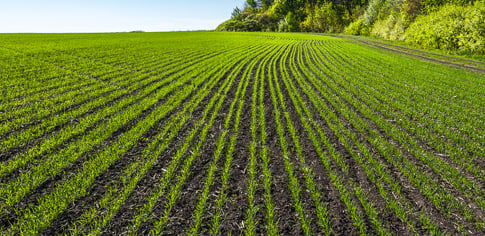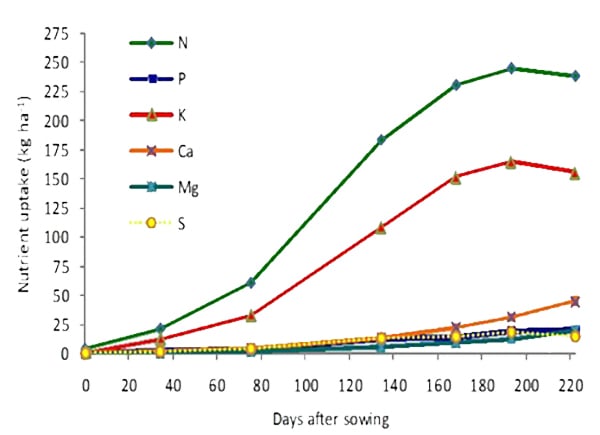Conselhos nutricionais para a cultura do trigo
Tudo o que você precisa saber sobre fertilização de trigo, melhores práticas, produtos adequados, ensaios de campo e muito mais
Conselhos para o cultivo de Trigo(Triticum spp.)
-
O pH ideal para o trigo de inverno é 6,5.
-
Os rendimentos da maioria das cultivares podem ser marcadamente reduzidos onde o pH está abaixo de 5,5, principalmente devido à suscetibilidade às deficiências de P, Mo e Ca.
-
Com pH >7,5, é provável que surjam deficiências de B, Cu, Fe, Mn, P e Zn. O trigo pode ser cultivado em praticamente todos os tipos de solo, exceto em solos arenosos muito leves ou em turfosos.
-
O trigo de inverno é amplamente cultivado em zonas temperadas (na Europa, Ásia e América, até 60 °N) e em altitudes mais altas em algumas áreas tropicais/subtropicais.
-
A temperatura mais favorável para a floração, iniciação de grãos, formação de grãos e maturação é de 20-25 °C.

Trigo de inverno saudável em fase de crescimento

Necessidades nutricionais
Captação estimada de nutrientes (kg/ha):
| Variety | Yield t/ha | N kg/ha | P2O5 kg/ha | K2O kg/ha |
|---|---|---|---|---|
| Winter wheat | Biomass* (DM): 13.7 Grains: 6.7 | 187 130 | 55 39 | 252 51 |
| Spring wheat | Biomass* (DM): 9.0 Grains: 4.5 | 129 100 | 58 50 | 125 25 |
*Toda a parte aérea da planta
Fonte: Adaptado de Aigner et al., 1988
Dinâmica da absorção de nutrientes ao longo de uma safra de trigo

Referência: Hirzel e Undurraga, 2013
Papel dos nutrientes
| Key parameter | N | P2O5 | K2O | MgO | CaO | SO3 |
|---|---|---|---|---|---|---|
| Yield | +++ | + | ++ | + | + | + |
| Protein content | +++ | + | ++ | + | +++ | |
| Vegetative growth | +++ | + | + | ++ | + | + |
| Root system | + | +++ | + | ++ |
+ = melhoria
– = piora
+/- = resultados diferentes, dependendo da taxa de nutrientes aplicada
Fonte: Boletim IPI – Cereais
Fonte: Trigo de inverno – Ficha de aconselhamento de culturas (Campus de Agronomia)
Deficiências nutricionais
| Nutrient | Description | |
|---|---|---|
| Nitrogen | Plants are pale green to yellow with chlorosis beginning on lower leaves and progressing upwards as the deficiency intensifies; plants have spindly stems and growth is slow. | |
| Phosphorous | P deficient plants may remain darker green than normal plants and develop purple discoloration first on the underside and later throughout. Leaf tips may die back when P deficiency is severe. Plants grow slowly, stems are thin and shortened and maturity is delayed. P deficient plants also exhibit poor tillering. | |
| Potassium | K deficiency is initially manifested as chlorosis on the older leaves and progresses upwards as the deficiency intensifies. .The leaves eventually become streaked and take on a scorched appearance along the leaf margins. Chlorotic areas may develop throughout the leaf. Deficiency symptoms can occur in young leaves of some fast-maturing high-yielding varieties. Stems of deficient plants are weak and tend to lodge. | |
| Sulphur | Symptoms are similar to nitrogen deficiency, but the chlorosis is uniform and general, throughout the entire plant, including younger leaves. Sulphur deficiency is most likely on sandy, free draining and soils low in organic matter. | |
| Calcium | Ca deficiency is very rare on small grains. Plants are severely stunted, and new leaves exude a gelatinous-like material, causing new leaves to stick together. Because Ca deficiency is favored by low pH (<5.2) and low soil Ca, aluminum-, and manganese- toxicity symptoms will usually be exhibited before Ca deficiency symptoms. | |
| Magnesium | Typically, Mg deficiency is found on soils with a pH of less than about 5.2. Also, wheat is unable to absorb adequate Mg in cool, wet springs. |
|
| Zinc | Cereals Zn deficiency generally shows up in early growth stages, when plant is only ~10 cm high, appearing first as yellow streaks in the young leaves, with a white to yellowish tip. White spots often appear on the leaves, or along their edges, and a portion of the marginal area may die. The entire plant is frequently stunted. | |
| Boron | Terminal shoots die. Leaves die back from tips, and young leaves remain rolled. (Similar to calcium deficiency) B- deficient plants produce very thin ears with much reduced grain yield. | |
| Copper | Cu deficiency tends to appear in the youngest leaves. Leaf twisting and white leaf tipping. Severe yield reduction. Copper deficiency may be due to low soil availability, or low total soil copper, and is problematic on light, acidic soils, low soil organic matter, granite parent materials, and dry soil. | |
| Iron | Iron deficiency starts out as an interveinal chlorosis of the youngest leaves, evolves into an overall chlorosis, and ends as a die-back of the chlorotic leaves. | |
| Manganese | At early stages, light chlorosis appears on the young leaves. At more severe cases, mature leaves show netted veins. Then leaves develop brown-grey necrosis along the veins. Chlorotic flecks pattern, concentrated mainly at the leaf base. |
Fonte: https://vikaspedia.in
A influência dos nutrientes para a resistência do trigo
Fonte: Datnoff L., Elmer W., Huber D., 2007: Mineral nutrition and plant disease, ASP Press, St. Paul, USA, 278 s.
Q&A
Aqui estão algumas perguntas frequentes que recebemos dos agricultores sobre o trigo.
-
Para obter o melhor rendimento, devemos fornecer os elementos na quantidade e no tempo adequados. Uma análise do solo pode ajudar a evitar quaisquer deficiências.
-
O teor de proteína está ligado ao nitrogênio. Portanto, é importante que a planta tenha nitrogênio disponível no estágio de alongamento do caule.
-
Para melhorar a rentabilidade da cultura, é importante usar uma nutrição eficiente, evitando fornecer elementos em excesso (uma análise do solo pode ajudar) e elementos disponíveis nos estágios corretos. Para isso, o uso de CRF é a principal solução.
-
Sim, pode ser útil, em particular, em solo de baixa MO, mas você deve incluir os elementos no cálculo do programa de fertilização para não ter excesso de elementos (em particular nitrogênio).
-
Em algumas áreas com alto teor de potássio no solo é possível atingir alto rendimento mesmo sem adubação potássica, considerando também que o trigo está em rotação e o K é aplicado em outras culturas.



